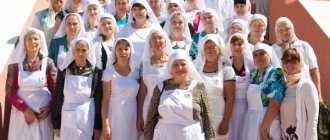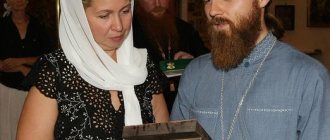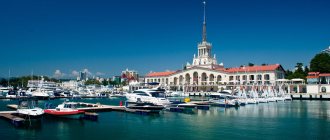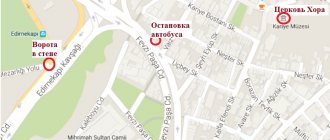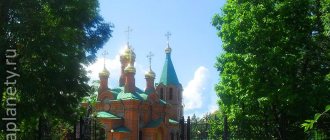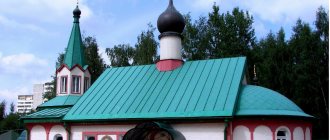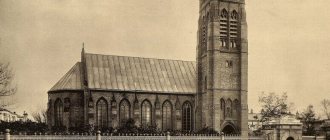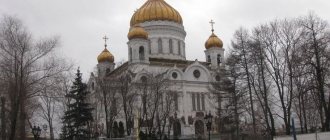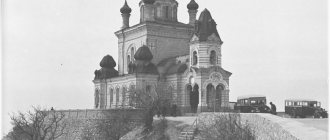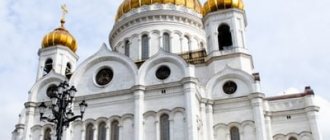Short story
Perhaps no other temple in the city is shrouded in so many legends and traditions as this one. According to one version, the shrine was built on the spot where in 1552 there was a royal tent, from which Ivan the Terrible watched the crossing of his troops across the Oka
during the Kazan campaign.
A strong wind was blowing, and the king caught a cold, and upon recovery, he ordered the foundation of a church in the name of the holy brothers Cosmas and Damian - healers and miracle workers who suffered martyrdom in Rome
. The Murom squad, which took part in the assault on Kazan, turned the outcome of the battle. The victory over Kazan was marked by the construction of several stone churches in Murom.
Tradition says that five Murom governors who fell in the battles for Kazan are buried under the Kosmodemyansky temple. According to another legend, Ivan the Terrible pitched his tent here, contemplating a plan to capture the Tatar stronghold. On the opposite bank of the Oka there was an enemy camp that interfered with the crossing of Russian troops. Not far from the sovereign's tent was Kuznetsky Posad.
Two blacksmith brothers - Cosmas and Damian - offered their help to the king. Dressed in Tatar clothes, they made their way into the enemy camp and set fire to the Khan’s camp. Taking advantage of the commotion, the Russian detachment crossed the river and defeated the enemy army.
Cosma and Damian died tragically, and a beautiful church was erected in their honor. There is also a version that on the site of the Kozmodemyansky temple in 1534 there was a wooden church in the name of Elijah the prophet. In 1564, a new stone temple was erected with funds donated by Murom merchants and townspeople.
Kozmodemyansk Church - an example of Russian tent-roofed architecture
The Temple of Cosmas and Damian is devoid of architectural delights. The church is made of an octagon and a ram, standing on a basement specially built for it, which in the old days was used for the burial of the clergy. Each wall of the quadrangle is divided into three parts by narrow pilasters. The entrances are framed by portals in the form of arches tapering inward.
The cornice of the quadrangle is surrounded by a curb ornament. The pride of the ancient temple was a sixteen-sided tent, which collapsed from disrepair in 1868. For a long time, the dilapidated church was crowned with something like a flattened copper helmet, but, fortunately, it was restored in 2009
. A drum decorated with an interlacing of keel-shaped kokoshniks was built to the level of the cornice. And on top of the drum they installed a multifaceted ribbed tent, crowning it with a bulbous dome with a cross.
Kozmodemyansk Church before restoration
Despite its modest size, art historians place the Church of Cosmas and Damian on a par with such famous architectural monuments as the Church of the Ascension
in the village of Kolomenskoye,
St. Basil's Cathedral
on Red Square in Moscow. This coincidence is by no means accidental: according to one version, the Kozmodemyansk church was built by the Pskov masters Barma and Postnik, who created the Moscow St. Basil the Blessed.
Attraction rating
Rating 3.50 [2 vote(s)]
| ← MUROM | VLADIMIR REGION | RUSSIA → |
Text of the book “Orthodox Moscow. All temples and chapels"
Cosmas and Damian, holy unmercenaries, church in Kadashi
(destroyed).
In the vicinity of the ancient villages of Khvostovskoye, Golutvino and Kolychevo, the Volotskaya and then the Serpukhovskaya roads passed, which determined the location of the future Bolshaya Polyanka street. Here in the 16th century there was the palace village of Kadashevo (first mentioned in the spiritual charter of Ivan III in 1504) and Tkatskaya Sloboda. In the 17th–18th centuries, Bolshaya Polyanka was called Kosmodamianskaya Street after the Sloboda Kadashevskaya church. It was built under Ivan IV the Terrible. The wooden temple burned down in the middle of the 17th century, and in its place in 1655–1656. wealthy Kadashevite Philip Savelyev built a five-domed stone temple. Like the previous one, this temple had the main altar of the Nativity of the Blessed Virgin Mary and the chapels of St. Nicholas and Saints Cosmas and Damian. Thirty years later, a third chapel appeared in the attached refectory - St. Sergius of Radonezh. In the 1730-1740s. Instead of the dilapidated bell tower of the 1650s, a new five-tiered belfry was erected, which had an unusual two-tiered walkway on columns.
The decoration of the temple was a five-tiered baroque carved iconostasis of the 17th century with forty-five icons of the same time, restored in 1899 by Ya.E. Epanechnikov. Many 17th-century icons were also in the altar. As the main shrine, parishioners revered the 16th-century temple icon of Saints Cosmas and Damian, decorated with diamonds, in a marble icon case, and with it reliquaries containing particles of the relics of Cosmas and Damian. In the iconostasis, the icon of the Savior of the 16th century and the signature image of John the Baptist from 1685 stood out. Museum workers especially noted the icons of the Holy Trinity and the temple Nativity of the Blessed Virgin Mary of the first half of the 17th century. A rare church monument was preserved in the sacristy - a throne from 1656, and with it a column for relics placed during the bishop's consecration of the temple. Liturgical vessels were made of crystal. The temple was illuminated by three bronze and silver chandeliers of the 17th century, crowned with double-headed eagles, and candlesticks of the 17th–18th centuries. Among the bells, the so-called Italian bell of 1707 stood out.
In 1922, Soviet officials removed 14 pounds of church silver from the temple. On December 28, 1929, the Presidium of the Moscow Soviet decided to close the Cosmodamian Church and transfer it to the club of workers of the Dunaev printing house. Representatives of the OGPU HOZO half-destroyed the unique iconostasis, removing and taking with them the platbands and other carved wooden decorations to wash off the gold. They also took away the furniture. Some of the most valuable icons entered the Tretyakov Gallery. In the early 1930s, the temple was dismantled, and in its place in 1939 a six-story residential building was built (Bolshaya Polyanka Street, 4).
Cosmas and Damian, holy unmercenaries, in the Kosmodemyanskoe church
(Khimki, Pravoberezhnaya street, house no. 6).
In 1726–1730 In place of the wooden one, a small stone temple in the Baroque style was built here. A four-tier iconostasis was installed in it, in the first row of which was the family icon of the village owner V.N. Zotov with the holy faces of Basil the Great and Nikita the Confessor. In 1812, the French destroyed the dilapidated temple, and it remained inactive for several years. Only by 1820 was it repaired, a new bell tower erected and services resumed. In 1889, the chapel of the blessed Prince Alexander Nevsky was built (architect A.A. Nikiforov). The temple was closed in 1940, the bell tower was dismantled down to the first floor, and the refectory was built on the second floor. Regular services were resumed in 1994. In the church there is a particularly revered icon of the unmercenary saints Cosmas and Damian, a particle of their relics, an icon of Alexei, Jonah and Hermogenes, the Moscow saints with particles of relics.
Cosmas and Damian, holy unmercenaries, church on Maroseyka
(Maroseyka street, house No. 14/2, building 3).
At the corner of Maroseyka Street and Starosadsky Lane stands one of the most cozy Moscow churches - Saints Cosmas and Damian. The first mention of a church in this area dates back to 1625. The current church was built in 1790–1793. according to the project of the great M.F. Kazakova. In December 1793, the southern chapel of St. Nicholas was consecrated. In 1795, the chapel of Saints Cosmas and Damian was consecrated. This completed the warm part of the temple. The main temple (summer) in the name of Christ the Savior, Healer of the Paralytic, was consecrated only in 1803. It had a very rare dedication, the only one in Moscow. It is only known that shortly before this, in the 1780s, the miraculous icon “Savior, Healer of the Paralytic” became famous in the village of Vedernitsy, Dmitrov district. It is described as being small in size, inserted into another board, and having a gilded silver frame with precious stones. The antimension of the St. Nicholas chapel, the altar Gospels, crosses and icons in the form of medallions with particles of the relics of Saints Cosmas and Damian were transferred from the old church to the newly built one. Muscovites liked the newly built temple; they were especially attracted by its unusual round shapes and miniature size. The appearance of the temple in the style of classicism is very laconic. The altar part and the side chapels are equal in height to the main volume, which is crowned by a rotunda with a small octagonal drum. A two-tier bell tower adjoins the refectory. In 1893 the temple was re-painted. Unfortunately, these paintings have not survived.
The church was closed in the late 1920s. In 1958, it was placed under protection as an architectural monument and restoration began. Externally, the building was repaired, the crosses and spiers were gilded, the fence was restored, but the interior remained disfigured: floors and many partitions. In 1993, the temple was handed over to the community of believers. A lot of work was done to bring the interiors of the church into proper shape. The first prayer service in the newly opened church took place on April 18, 1993.
Cosmas and Damian, holy unmercenaries, church in Nizhniye Sadovniki
(destroyed).
In the vicinity of Bolotnaya Square, on the embankment of the Moscow River, lived the royal gardeners who were part of the Nizhnyaya Sadovnichiya Sloboda (there were also the Middle and Upper Sadovnichiya Slobodas). Their gardens and vegetable gardens spread out on the fertile floodplain lands, and among them stood the Sloboda Church, built no earlier than 1610 (documented since 1625).
A stone temple instead of a wooden one was built in 1657, almost simultaneously with another Zamoskvoretsky Kosmodamiansky temple on Bolshaya Polyanka. The main altar was consecrated in honor of the Vladimir Icon of the Mother of God, and the chapel in the name of Saints Cosmas and Damian. Five years later, a single-pillar refectory with a chapel to St. Nicholas was added. In 1689–1690 A high tented bell tower was added to the refectory. In 1767, the Kosmodamian chapel was moved to the southeastern part of the refectory. In the second half of the 18th century, not far from the temple, a vast building of the Kriegs Commissariat, an institution in charge of supplying the army, appeared. The temple in Nizhnye Sadovniki stood out for its amazing decorative multi-colored five-domed drums, zakomaras, platbands and portal.
By decision of the Moscow Regional Executive Committee on July 12, 1931, this amazingly beautiful church was transferred to Mosselprom for use as a canteen. In the mid-1930s, the fabulous monument of pre-Petrine architecture was demolished. Now in its place is a six-story residential building.
Cosmas and Damian, holy unmercenaries, church in Starye Kuznetsy
(destroyed).
It was located in Zayauzye, in Kuznetskaya Sloboda, near the intersection of Goncharnaya Street and 3rd Kotelnichesky Lane. The parishioners of the temple were blacksmiths and armor smiths, who considered Saints Coema and Damian their patrons. At the end of the 15th century, in this area there was a village of the boyar Prince Ivan Yuryevich Patrikeev, in whose charter of 1498 the Kosmodamian Monastery was first mentioned, which was later abolished. The monastery church was rebuilt in stone in the 16th century, and in 1657 the chapel of St. Philip, Metropolitan of Moscow, was added to it. In 1745, a new bell tower was erected. The church changed its appearance in 1769–1770, 1855, 1863–1869 and 1899, expanding and beautifying with the zeal of wealthy parishioners A.V. Zubova, D.I. Khludova, S.I. Lyamina. There, on Goncharnaya Street, stood the Church of Cosmas and Damian the New (the saints of the same name, but different ones). This neighborhood gave rise to the legend of two rich brothers who built a church, but then quarreled. Then one of them decided to separate from his brother in everything and built a second Cosmodamian church next door.
In the early 1930s, parishioners of six closed surrounding churches gathered under the arches of the small temple of Cosmas and Damian the Old. But the same fate awaited this temple. In 1936, the old church was demolished, and in its place in the 1950s. built a multi-storey residential building.
Cosmas and Damian, holy unmercenaries, church in Starye Paneh
(Staropasky Lane, building No. 2–4).
The oldest part of the church - the altar - was mentioned already in 1468. The temple received its name “in Stary Panekh” from the nearby Polish “Panskiy Dvor”, known here since 1508. The temple was rebuilt in stone in 1564, and, possibly, preserved fragments of the original building. According to legend, in this temple Ivan the Terrible married his sixth wife, the widow of the clerk Vasilisa Melentyeva. Initially, the temple was crowned with five domes mounted on a double-height quadrangle of the main volume. In the 17th century The church became a suburb for the patriarchal singers who settled in this area. In 1640, the Assumption Church was added to the church from the north. In 1803, the temple was extensively rebuilt in the style of classicism.
The chapels of the Dormition of the Blessed Virgin Mary and St. John Chrysostom were created in it. A new bell tower was also built. The Zlatoust chapel was abolished in 1878.
Currently, the temple is an asymmetrical structure that combines elements of buildings from different times; it is strongly squeezed by the surrounding buildings and is visible only due to the fact that its northern façade faces the red line of Staropasky Lane. Two tent domes have been preserved.
In 1926–1927 the church was restored under the leadership of D.P. Sukhova. In 1929, the temple was closed and the refectory and bell tower were destroyed. In the 1960-1980s. the traffic control department was located here. In 1993 it was handed over to the community of believers. Worship services resumed in 1995.
Cosmas and Damian, holy unmercenaries, church in Tagannaya Sloboda
(destroyed).
The Church of Cosmas and Damian the New has been known in Tagannaya Sloboda since 1625. The temple was called New in contrast to the church of Cosmas and Damian the Old located next door in Starye Kuznetsy. Based on the name of the temple, the nearest lane was called New Kosmodamiansky (since 1954 - 2nd Kotelnichesky). The first stone church on this site was consecrated on October 12, 1662, as reported by a foundation board installed in the wall of the temple. Since 1722, the refectory has been a chapel of the Nativity of the Blessed Virgin Mary. In 1732–1745 The temple and bell tower were rebuilt. In 1754, a chapel of the Apostle John the Theologian was built in the refectory. In 1859, architect N.I. Kozlovsky changed the shape of the windows and expanded the temple by adding two more chapels - the righteous Simeon and Anna and the prophet Elijah. In these chapels, on December 30, 1896, new marble iconostases were consecrated. The main iconostasis was created in the middle of the 18th century.
The church was closed at the end of the 1920s and was gradually rebuilt for secular purposes until it became a six-story building (Goncharnaya Street, house no. 20).
Cosmas and Damian, holy unmercenaries, church in Shubin
(Stoleshnikov Lane, building No. 2).
The first wooden temple in this area was built in the 14th century, next to the courtyard of the boyar Iakinf Shuba. In 1626 the church was rebuilt in stone, and in 1702–1722. rebuilt with the inclusion of part of the previous building. The main altar was consecrated in honor of the Annunciation of the Most Holy Theotokos, but the temple was named after the chapel. On the main volume of the quadrangle there is an octagon, ending with a baroque cupola with an openwork cross. Forged iron doors from the 18th century have been preserved in the interior of the temple.
The stone church of 1722 was rebuilt several times. In 1820–1823 from the north it was joined by the chapel of the Resurrection of the Word, which was moved from the dismantled Church of the Resurrection of the Word on Dmitrovka. In 1840–1842 The temple was renovated, a new three-tiered main iconostasis was built. In 1857, a new chapel of Saints Cosmas and Damian was built on the south side and a high bell tower was erected in the Russian-Byzantine style. In 1889 the walls were painted. In 1897 the temple was renovated. At the beginning of the 20th century. the regent of the temple was the outstanding spiritual composer P.G. Chesnokov.
The church was closed in 1929, the dome and the top of the bell tower were demolished. During the Soviet years, there was a Library of Foreign Literature and a printing house here. Since the late 1970s. the church was restored.
Divine services resumed in 1991. In 1997, the temple icon of Saints Cosmas and Damian, which was kept in the nearby Church of the Resurrection of the Word in Bryusov Lane, was returned. Another shrine of the temple is the icon of the blessed Matrona of Moscow with a particle of her relics.
Ksenia, Venerable Church at the Kseninsky Shelter in Khamovniki
(destroyed).
The women's shelter was opened in 1876 in memory of the birth of Grand Duchess Xenia Alexandrovna, daughter of Alexander III, and later included a craft and teacher training department for primary schools. At the beginning of the 20th century, the shelter building was built on a third floor, where a small Kseninsky temple was built, connected to a large assembly hall. The consecration of the temple took place on January 28, 1901. It contained a three-tiered wooden iconostasis, seventeen icons, vestments, and church utensils. In 1920, the temple was liquidated, and in 1922 the orphanage building (Nesvizhsky Lane, house No. 3) was transferred to the chemistry department of the Moscow Pedagogical Institute.
L
Lazarus the Righteous Church at the 2nd City Hospital
(Leninsky Prospekt, building No. 10).
The architectural complex of buildings of the 2nd City Hospital took shape during the second half of the 19th – early 20th centuries. An important place among the buildings was given to Orthodox churches. In 1892, in the courtyard of the hospital, the consecration of a new church, rebuilt from a small chapel, took place in the name of the righteous Lazarus. The main purpose of this building is to hold services for patients who have died in the hospital. The temple was located in the depths of the land plot, on the high bank of the Moscow River, in a place quite difficult for construction due to geological conditions. According to old photographs, the appearance of this small, one-story brick temple was laconic. Strict profiles of stucco frames decorated the rectangular windows of the main volume of the building and the arched window openings of the hemispherical apse. The massive ground floor in the north-eastern part made the temple somewhat heavy, but strengthened the strength and reliability of the structure erected on the mountainside. A small onion-shaped dome with a cross crowned the entire building. It is currently difficult to judge what the internal appearance of the temple was due to the lack of photographic, documentary and memoir evidence from contemporaries.
It can be assumed that the active life of the temple in the name of righteous Lazarus in the 2nd City Hospital lasted just over thirty years. Based on a publication in Izvestia on May 24, 1923, which reported the closure of the city's hospital churches, the most likely date for its abolition can be considered 1923. In the subsequent period, the building changed owners with enviable regularity and stood abandoned due to its remoteness from the main highways of the city. The beginning of the 1990s was marked by its transfer to a new owner and major renovations, which completely distorted the original appearance of the building. It is difficult to explain its complete oblivion by researchers and architectural historians only by its remote location. Like other secondary hospital churches in Moscow, the Church of the Righteous Lazarus was practically not subjected to field research and was not put forward for registration with the Office for the Protection of Cultural Heritage. But the church building has survived to this day and can be restored.
Lazarus, the righteous, chapel in Rozhkov
(Zelenograd, Rozhkovo village, Zelenograd cemetery).
The village of Rozhkovo is located on the border of Solnechnogorsk district and Zelenograd. The modern city gradually expanded its territory and came close to the village. Currently, a new city cemetery has been built on its territory. In 1997, a chapel was built at the cemetery. In 1998, it was already erected and solemnly consecrated in the name of the righteous Lazarus of the Four Days on April 11, 1998, on Lazarus Saturday (the day when the Orthodox Church remembers the great miracle of the Savior - the Resurrection of Lazarus from the dead). The brick, plastered and whitewashed chapel with one cupola covered with copper was built in the style of Novgorod-Pskov architecture of the 14th–15th centuries. The project was developed by architects I.A. Pokrovsky and Yu.A. Sverdlovsky. She stands in front of the entrance to the cemetery. The inside of the chapel is decorated only with icons, its walls are not painted. Funeral services and memorial services for the deceased are held here.
Saint Luke (Voino-Yasenetsky) at the Scientific Center for Cardiovascular Surgery named after A.N. Bakulev Church
(Rublevskoe highway, house No. 135).
The house church of the Scientific Center for Cardiovascular Surgery was consecrated in the name of St. Luke, who became famous in the first half of the 20th century. as a church leader and as an outstanding surgeon.
M
Maxim the Confessor, Venerable (Maxim the Blessed), church on Varvarka
(Varvarka street, house no. 4).
In the second half of the 14th century. On one of the main streets of the Moscow Posad, Varskaya (later Varvarskaya) street, the Church of Boris and Gleb was built. In 1434, the Moscow holy fool, Saint Maxim the Blessed, was buried in it, in whose name a chapel was built and the temple received a second name. In 1568, a stone church was built here with a main altar in the name of Maximus the Blessed and a southern aisle in the name of St. Maximus the Confessor. In 1698–1699 the temple was significantly rebuilt, incorporating part of the previous building. During the terrible fire of 1737, the church was badly damaged and was revived in the Baroque style. This is a pillarless double-height temple, topped with a light drum and an onion dome. The dome also rises above the altar in the refectory. High basements of the temple in the 16th–18th centuries. served as storage facilities for the townspeople's property from fires. Fragments of frescoes from the 18th–19th centuries have been preserved in the interior of the temple. In 1827–1829 a new bell tower was erected. The temple was rebuilt in the mid-1840s. At the end of the 1920s. the regent of this church was the monk Pimen (in the world Sergei Mikhailovich Izvekov), the future patriarch.
The temple was closed in 1931, after which its heads were broken. In 1956–1969 the building was restored, restoring the chapters. Since 1970, the temple has been under the jurisdiction of the All-Russian Society for Nature Conservation. In 1991 it was returned to the Russian Orthodox Church. Worship services resumed in 1995.
Mary of Egypt, Venerable Church in Sretensky Monastery
(destroyed).
The wooden church of St. Mary of Egypt was built in 1385. Tradition connects its origin with the execution at this place - Kuchkovo field - of the thousand Ivan Vasilyevich Velyaminov and his accomplice, the merchant Nekomata, whom the people considered to have suffered for the truth.
In 1482 the church was rebuilt in stone. In 1700, part of the relics of Mary of Egypt, brought from Constantinople by Ambassador Emelyan Ukraintsev, was placed in it. In February 1707 they were moved to the monastery cathedral, but on the feast of Mary of Egypt they were transferred to the church named after her for a week. In 1706, through the zeal of parishioner A.A. Milyutin added the chapel of the Presentation of the Lord to the temple, and in 1784, with donations from the manufacturer A.A. Goncharova renovated the entire building. Nevertheless, the ancient monument quickly deteriorated, and in 1832 it had to be closed. There were even proposals to dismantle the temple, but the Moscow Archaeological Society defended the historical relic.
In 1883, the church building was tied together with three iron hoops, and it survived safely until the beginning of the 20th century. And suddenly, in a book published by the Sretensky Monastery in 1911, Muscovites discovered strange words about the ancient church: “Architecturally and archaeologically, it does not represent anything outstanding, and with its inappropriate position it embarrasses the monastery graveyard and spoils the appearance of the cathedral church. In view of this, without any particular loss for archaeological science, this church can be completely demolished, especially since its architecture is exactly the same as the architecture of the cathedral church next to it.” Such a statement caused great concern among members of the Moscow Archaeological Society. Experts drew attention to the poor state of preservation of the monument: the windows were broken, there were heaps of rubbish everywhere. The temple was brought into relative order and, thanks to the efforts of the public, was not touched in the pre-revolutionary years.
In 1928–1929 The bell tower and St. Nicholas Church of the Sretensky Monastery were demolished. Following this, it was the turn of the ancient temple of St. Mary of Egypt. It was destroyed in 1930. In the temple there was a reliquary with parts of the holy relics of Mary of Egypt and the blessed Prince Mikhail Yaroslavich Tverskoy, the latter was transferred after the closure of the temple to the State Historical Museum.
Mary Magdalene, Equal to the Apostles, Church in the Widow's House
(Barricade Street, house No. 2; destroyed).
The Widow's House (originally the Invalid House), one of the largest and oldest charitable institutions in Moscow, was built in a huge building with columns on Kudrinskaya Square. The building was built around 1785 (architect I. Gilardi). Since 1811, it housed an almshouse for widows and orphans of military personnel and officials. After the fire of Moscow in 1812, the complex of the Widow's House was completely rebuilt by D.I. Gilardi (1818–1823). The Church of Mary Magdalene was created in 1805, and in 1818 the temple was consecrated anew. There were nine icons in the two-tier carved gilded iconostasis. A large number of icons, including those on canvas and oval ones on zinc, were located on the walls. Especially notable were the Chernigov Icon of the Mother of God in a silver robe decorated with precious stones and the Iveron Icon of the Mother of God on a gilded wooden lectern in a carved gilded frame behind glass. In a wooden frame on the wall there was a huge image of the Lord Pantocrator and the Holy Trinity on canvas.
The church was closed in 1918. Church utensils and icons were transferred to the Church of St. George in Gruziny and the Spassky Church under construction at the Ufa courtyard at the Presnenskaya outpost. An auditorium with a stage for theatrical performances was built in the church building. Nowadays the building houses the Russian Medical Academy of Postgraduate Education.
Mary Magdalene, Equal to the Apostles, church at the Imperial Moscow Technical School
(2nd Baumanskaya Street, building No. 5; destroyed).
The Imperial Moscow Technical School (now Moscow State Technical University) was located in the former Slobodsky Palace, an architectural monument of the second half of the 18th century. The Church of Mary Magdalene in the Empire style was built in 1832 in one of the halls on the third floor. It could be entered from both sides via stairs leading from the second floor to the third. The church room was divided into three parts by columns lined with white marble and illuminated from the dome. The semicircular altar had a stone vault above the altar, supported by four columns. The altar was illuminated by three windows. The temple was famous for its white and gold, semicircular shape, carved Empire style iconostasis and artistic church utensils of the 1830s. Connoisseurs of church art noted the artistic value of church paintings on canvas, icons of Equal-to-the-Apostles Mary Magdalene and St. Nicholas, the altarpiece with seven candlesticks, the altar cross, a jug for holy water and other objects.
Divine services in the church stopped soon after the October Revolution of 1917. In 1923, an Empire style iconostasis with icons, seven more icons, candlesticks, six large paintings, a silver cross with niello from the early 19th century and other church property were taken to the museum collection. The remaining icons and church utensils were taken to the Mosfinotdel warehouse on Pokrovka.
Mary Magdalene, Equal to the Apostles, church at the dacha of the Nikolaev Orphan Institute
(destroyed).
In the early 1890s. behind the Dorogomilovskaya outpost at the dacha of the Nikolaev Orphan Institute, in the country courtyard of the Orphanage, a wooden one-domed church was built (architect M.G. Pryzhov). It was consecrated on July 11, 1893 in the name of Equal-to-the-Apostles Mary Magdalene. You could enter the temple through the large institute dining room. Apparently, the temple was closed and destroyed in the 1920s.
Mary Magdalene, Equal to the Apostles, at the Commercial School
(Ostozhenka street, house no. 38).
During the era of Peter I, the city estate on Ostozhenka was in the possession of Prince D.A. Koltsov-Mosalsky, from whom she passed to the cabinet secretary and associate of the emperor-reformer Alexei Vasilyevich Makarov. At this time (in the 1720-1730s) stone chambers were built here. In 1764–1772 by order of the new owner P.D. Eropkin, a new manor house was erected. Pyotr Dmitrievich Eropkin became famous for the fact that in 1771 he managed with a small military team to defeat the rebels during the Plague Riot in Moscow. Subsequently, from 1786 to 1790, he served as Moscow governor-general. At the beginning of the 19th century. his house was transferred to the Commercial School, for the needs of which it was rebuilt several times. In 1807–1808 its restructuring was carried out by D.I. Gilardi. The house acquired its modern appearance when it was restored after the fire of 1812. It is a monumental, three-story classic building located in the depths of the courtyard. Inside, chambers with vaulted rooms and late classical interior decoration have been preserved.
The school church of Equal-to-the-Apostles Mary Magdalene was consecrated on February 13, 1816, later moved to another building, which was consecrated on March 21, 1854. In the first half of the 19th century. the rector of the temple was priest M.V. Soloviev, father S.M. Solovyova. The great historian spent his childhood years in this house (a memorial plaque was installed). In November 1904, the Commercial School solemnly celebrated its 100th anniversary.
A few days before the celebrations, on November 7, the renovated school church was consecrated. It had a three-tiered iconostasis gilded, the walls were decorated with pink marble, the vaults were covered with paintings, presumably made by M.V. Nesterov and V.M. Vasnetsov.
The church was closed at the end of 1919. Part of the church property went to the Museum Fund, part was transferred to the church in the village of Kamenka, Bogorodsky district, Moscow province. Currently, the building of the former Commercial School houses the Moscow State Linguistic University (bearing this name since 1990), the temple premises have been rebuilt.
Mary Magdalene, Equal to the Apostles, in the juvenile department of the Nikolaev Orphan Institute church
(Kazakova street, house number 22; destroyed).
The juvenile department of the Nikolaev Orphan Institute accepted girls from 6 to 11 years old, who, after studying here, were transferred to the institute itself. At the end of the 19th century, about two hundred girls were raised in the department. The Church of Mary Magdalene in the building of the children's department was consecrated on June 4, 1845. There were many icons in the iconostasis and on the walls, including the icons of the “Blessing of the Children”, “The Visit of the Mother of God to St. Sergius”, and the Kovno Icon of the Mother of God in a silver robe. Soon after the October Revolution of 1917, the building of the children's department was occupied by the Tuberculosis Institute, and later by the Physical Education Institute. Services in the church stopped, and at the end of 1921 its property was taken to the churches of the village of Obraztsovo, Bogorodsky district, Moscow province, and the village of Dudino, Tver province. Nowadays the building houses the Research Institute of Physical Education.
Mary Magdalene, Equal to the Apostles, church in the Nikolaev Professional Women's School
(Solyanka Street, building No. 14a; destroyed).
The school belonged to the Nikolaev Orphan Institute, and pupils no younger than fourteen years old were educated there. Those who completed the course received the right to teach in primary schools, private homes and kindergartens. In 1891, in a room on the upper second floor of the school building, a temple was built to Equal-to-the-Apostles Mary Magdalene. There were nine icons in the single-tier wooden iconostasis and six more icons on the Royal Doors. In the church there was a reliquary with particles of the relics of Saints Basil the Great, Ermolai and Maxim, as well as an icon of the Crucifixion of Christ with a particle of the Life-Giving Cross of the Lord. In 1906, the temple was completely renovated. It was closed in December 1919, and the church property was transferred to the church in the village of Mordashevichi, Orsha district, Gomel province.
Mary Magdalene, Equal to the Apostles, church at the 1st City Hospital
(Leninsky Prospekt, building No. 8).
The main building of the largest Moscow hospital was built in 1828–1832. (architect O.I. Bove). The central building was crowned with a dome, under which was the Church of Mary Magdalene, consecrated in 1832. The temple was decorated with an Empire-style artificial marble iconostasis with a colonnade and an arch with carved gilded Royal Doors. The northern and southern doors of the iconostasis were a copy of Raphael’s paintings, and the image of the Last Supper over the Royal Doors was a fresco by Leonardo da Vinci. In the temple there were artistic silver liturgical vessels, a silver cross from the end of the 18th century with particles of relics. The icons in the iconostasis were painted by academician of painting Borovikov. There were about fifty more icons in the temple, many of which were distinguished by a high artistic level. The temple icon of Equal-to-the-Apostles Mary Magdalene was decorated with a crown, emeralds, aquamarines, and pearls. On the crown of the Kazan Icon of the Mother of God there were gold overlays, diamonds, and turquoise. The wall paintings were distinguished by their high quality of execution.
The temple was closed in May 1923, and its property was transferred to the museum fund. A conference room was set up in the church building. In the mid-1950s, its interior, rich in sculptural decor, was restored.
Mary Magdalene, Equal to the Apostles, church at the shelter for blind children
(Mira Avenue, house No. 13; destroyed).
The shelter was moved to 1st Meshchenskaya Street (now Mira Avenue) in 1912, and on November 14 of the same year the Church of Equal-to-the-Apostles Mary Magdalene was consecrated. It was located on the second floor, in a room adjacent to the assembly hall. The wall painting was executed under the direction of the famous icon painter S.A. Sokolov based on drawings by famous artists. The icons were painted in the Fryazhsky style on a gilded background. The lower tier of the oak iconostasis contained ten, the average – seventeen, and the upper – twenty-one icons. The icon “Healing of the Man Born Blind” was placed in front of the entrance. The northern and southern sides of the ceiling were painted with images of the four evangelists; on the western side of the vault there was an image of the appearance of Christ to Mary Magdalene. In October 1921, the temple was closed and sealed, and in December of the same year, all its property was transported to a warehouse for disposal.
